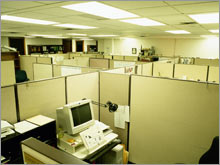How office redesigns boost the bottom lineCompanies that understand the link between workplace design and productivity can make dramatic upgrades on the cheap. Business 2.0 Magazine reports.(Business 2.0 Magazine) -- Sometime around 1985, I recall a student of mine showing me some research that proved to be light-years ahead of its time. It was a study by BOSTI, the Buffalo Organization for Social and Technological Innovation, that showed how the physical design of workspace had a direct effect on job satisfaction, productivity, and profitability--in settings ranging from high-rises to laboratories. Companies with workplaces that encouraged more informal mingling of employees, for example, outperformed those that sequestered their staffs in amaze of cubicles.   Yet in the ensuing years, I've seen these findings preached a lot more than practiced. Scott Adams built his Dilbertian empire by mocking oppressive "cube culture," and I still work in a building that has the floor plan of a jail. An April 2006 survey of more than 2,000 office workers commissioned by Gensler, a leading design firm, illustrates both the problems and the promise of workplace design. Nearly half of the respondents said they would work an extra hour a day if they had a better workplace environment. More than 90 percent reported that their office space affected their attitudes about work and that a different setup could make their companies more competitive. Yet employers seemed blind to the potential: Only 38 percent of workers said they would be proud to show important customers their workspace. About a third complained that it didn't promote health and well-being. And almost half thought that creating a productive workplace was not a priority at their companies. Yet it is possible--in fact, easy--to do better. Consider this insight, which came from the General Services Administration decades ago: Of the total cost to a company for running an office building over a 30-year life span, the initial construction represents just 2 percent; operating expenses come to about 6 percent. The remainder? It all goes to paying the workers inside. The point should be obvious: People are the biggest cost inside a work environment, so leveraging your human capital ought to be near the top of your priority list. But, of course, it isn't. And the great irony is that you don't have to construct a gleaming new office tower--such as Bloomberg's glass-walled masterpiece in Manhattan--to achieve real results. One management consulting firm, for instance, recently recognized that with its staff spending lots of time out of the office, there was limited opportunity for mentoring and information sharing, and that the workplace inhibited that. An analysis of traffic patterns in the office showed that a reconfiguration of the space to funnel traffic through common areas where people would naturally mingle would boost interaction 10-fold. At Electronic Arts (Charts), based in Redwood City, Calif., managers invited employees to plaster their cube dividers with design ideas and notes, and gave them "walls" to make it easier. Worker collaboration there has since gotten a boost. There are other ways to make improvements, such as doing post-occupancy evaluations--surveys to see how attitudes and practices have changed--so that learning from one project can be used in future workplace design efforts. Much of this research is being done in the WorkPlace 20.20 program of the General Services Administration, the nation's largest landlord. Workplaces affect interaction, attitudes, and even how we think about what we do. All that's required for improvement is the same thing required for any initiative: high-level involvement and an understanding that the most valuable things inside any office building are the people who work there. Business 2.0 columnist Jeffrey Pfeffer is the Thomas D. Dee II Professor of Organizational Behavior at Stanford University's Graduate School of Business. More from Business 2.0: The trouble with gee-whiz gadgets Next Net 25: Startups to watch |
Sponsors
|
